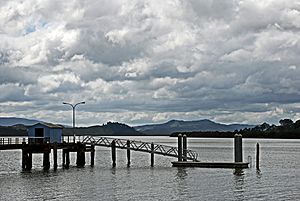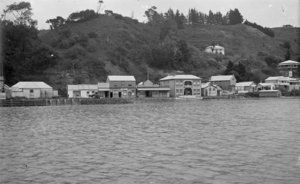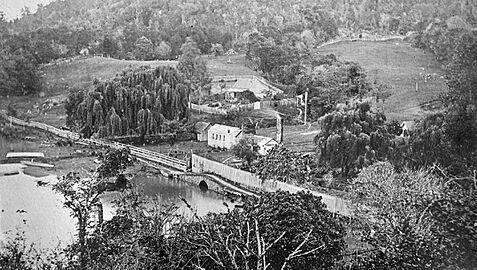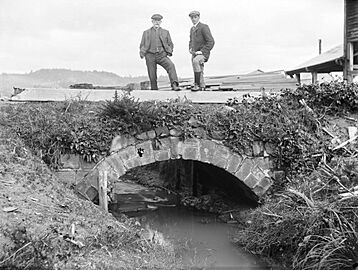Kohukohu, New Zealand facts for kids
Quick facts for kids
Kohukohu
|
|
|---|---|

Kohukohu Wharf
|
|
| Country | New Zealand |
| Region | Northland Region |
| District | Far North District |
| Ward | Kaikohe/Hokianga |
| Community | Kaikohe-Hokianga |
| Subdivision | North Hokianga |
| Electorates |
|
| Area | |
| • Total | 4.26 km2 (1.64 sq mi) |
| Population
(June 2023)
|
|
| • Total | 190 |
| • Density | 44.6/km2 (116/sq mi) |
Kohukohu is a small village in New Zealand's Northland Region. It sits on the northern side of the Hokianga Harbour. This village was one of the very first places where European settlers made their homes in New Zealand.
The harbour here divides into two rivers. The Mangamuka River goes northeast, and the Waihou River heads east. You can find other places like Mangungu and Horeke along the Waihou River.
Near where the harbour splits, there's a tiny island called Motiti. An artist named Augustus Earle painted it in 1827. He was the first European artist to spend several months in New Zealand. He described sailing on the harbour, seeing "majestic hills" and "headlands stretching into the water."
Contents
History and Culture of Kohukohu
Early Māori Settlement
According to Te Tai Tokerau stories, the famous Polynesian explorer Kupe visited this area. This was before he sailed back to Hawaiki. The name Kohukohu comes from a Māori word for a swearword. It is said that Kupe used this word because the food from a Hāngī (an earth oven) was not cooked enough.
European Arrival and Growth
The first European arrived in the Hokianga Harbour in 1819. By the 1830s, Kohukohu became a very important place for New Zealand's timber industry. The country's first Catholic mass was held near Kohukohu in 1838. Later, in 1878, the Hokianga Sawmill Company built a large sawmill here.
For almost 100 years, Kohukohu was a busy town for timber milling. It was the biggest business centre on the north side of the harbour. In 1900, nearly 2,000 people lived in the township.

Marae: Important Meeting Places
Kohukohu has three marae (traditional Māori meeting grounds). These marae are connected to the hapū (sub-tribe) called Te Ihutai.
- Pateoro or Te Karae Marae, with its Pōwhiri meeting house, is linked to Te Rarawa.
- Pikipāria Marae, with its Ngarunui meeting house, is linked to Ngāpuhi.
- Tauteihiihi Marae, with its Tokimatahourua meeting house, is also here.
There are also three other marae linked to different Te Rarawa hapū:
- Motuti Marae and Tamatea meeting house are connected to Ngāti Tamatea, Ngāti Te Maara, and Te Kai Tutae.
- Ngāi Tupoto Marae and Ngāhuia meeting house are connected to Ngāi Tūpoto and Ngāti Here.
- Waiparera Marae and Nukutawhiti meeting house are connected to Patutoka, Tahāwai, Te Whānau Pani, and Te Hokokeha.
In 2020, the New Zealand Government helped fund upgrades for Ngāi Tupoto Marae and eight other marae in the Te Rarawa area. This project helped create jobs for people in the community.
Kohukohu Bridge: A Historic Landmark
The Kohukohu footbridge is near the middle of the town. Many believe it is the very first stone bridge built in New Zealand. It is also the oldest bridge still standing in the country. It was built between 1843 and 1851. It crossed the Waihouuru Creek, which flowed into the Hokianga Harbour.
Ships from Sydney used to carry sandstone blocks as ballast. They would leave these blocks at Kohukohu to pick up valuable timber. These sandstone blocks were then used to build the bridge. In 1879, a timber mill opened next to the bridge. Sawdust from the mill was used to fill in parts of the harbour. This process, called reclamation, has buried most of the bridge. Today, the bridge is about 100 meters away from the water's edge. In 2008, the bridge was officially recognized as a Category 1 Historic Place.
- Kohukohu footbridge
People and Population
Kohukohu is a rural settlement. In the 2023 New Zealand census, Kohukohu had a population of 180 people. This was a small increase from the 2018 census. The median age in Kohukohu was 59.7 years. This is older than the national average for New Zealand.
Most people in Kohukohu identified as European (Pākehā). A significant number also identified as Māori. English is spoken by almost everyone. A small percentage also speak Māori language.
Education in Kohukohu
Kohukohu School is a school for students in years 1 to 8. It is a co-educational school, meaning both boys and girls attend. The school first opened in 1883. However, it moved to a new location in 1972. The original site was not stable, so a new building was needed. The old school site is now a historic reserve.
Notable People from Kohukohu
- James Fisher-Harris: A well-known rugby league player for the Penrith Panthers team.




